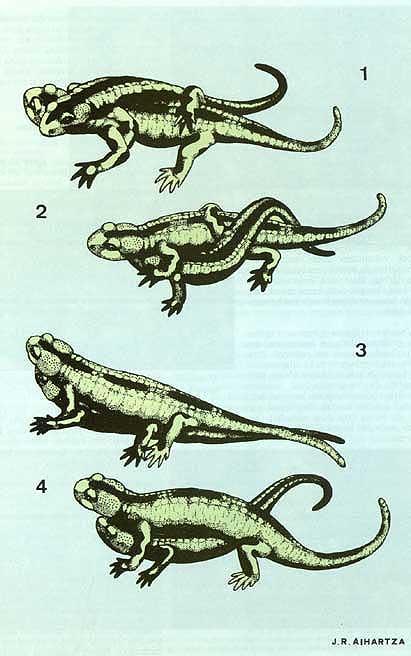Reproduction of the urodelos of Euskal Herria
However, for us not to be wrong, seeing these primitive characters does not mean at all that the oldest order among amphibians living today is formed by the urodelos. Moreover, this group presents not only these primitive characters, but also many other more modern particularities with respect to the rest of amphibians, including the primacy of internal fertilization.
On the other hand, all urodelos are characterized by being in their development a larval phase with gills. In most cases, this gill larva has a free aquatic life, and it is a waste that, like all adult amphibians, has to look for, catch and kill their prey to feed. For this, in addition to its great capacity for movement, the larvae of the urodelos need well-developed sensory organs, as well as the strength and ability to capture and kill their prey. This demands, of course, the existence of well-endowed eggs with vitellus that allows a long development prior to hatching.
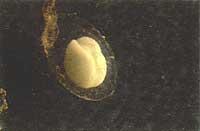
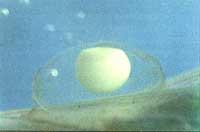
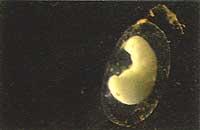

Dance courtship of Uhandre

As indicated, in most urodelos an internal fertilization is performed, for which the male forms spermatophores. These spermatophores are formed in special glands located in the cloaca of the male. They are usually small and gelatinous structures, conical or caliziform, which house inside a small mass of sperm.
In most cases, special courtwork should be done before internal fertilization. The model mentioned here is the one that is fulfilled in most of the urodelos, and it is the one that can be observed in the three species of the genus Triturus that inhabit the Basque Country; in the triton of the summits of T. alpestris, T. helveticus, in the palmate triton, and T. marmoratus, uhandre marmolaire.

A first step looks closely at the person who has been detected by vision and/or hearing. The males in heat use the snout for the repeated exploration of the newcomer, which in this work focuses mainly on the study of the ventral area and the sewer.
If you make sure your partner is female, the male "catches", being enough most of the time to close the road. While this symbolic capture lasts, the male begins to rub the female with the end, generating at the same time and taking advantage of the tail a stream of water towards the female. It is believed that through this movement the male sends to the female the secretions of the hedonic glands that the male has on its dorsal and lateral surface (especially at the end and tail), although its chemical nature is unknown, it has been detected that they affect the terminal ribs of the surface of the female.
In the next step, the male starts and the female, as if fascinated, continues closely, placing the gaze on some fragment of the male. One day the male stops leaving a spermatoforum at the bottom of the water. Finally, the male leads the female persecutor on the spermatophore, putting in contact the gelatinous mass that carries the sperm with the cloaca of the female.

If we analyze the specific behaviors of each step, the interspecific variability can be evident, being able to shorten, eliminate or even complicate some phases.
Once the fertilization is done, the female proceeds to the laying of the eggs. In this step, the female sewer is presented as a glando-muscular bulb to play the role of specialized ovipositor organ. In fact, these tritons place their eggs alone glued to the leaves of the aquatic plants, for which the female, helping with the hind legs, flexes the leaf around the egg. The adhesive substances segregated by the glands located in the sewer allow, if pressed for a few seconds, the leaf and egg to be joined, also obtaining an additional protective structure.
Usually the urodelos lay much less eggs than the anuros, which represents a different reproductive strategy. A smaller number of eggs are compensated on the one hand with the protection offered by vegetable leaves and, on the other hand, urodelos larvae have a higher supervisory rate than that of the anuros, whose residual nature allows them a greater competitive capacity.

Although the development of the triton larvae is similar to that of shoes, the differences are also notable. Unlike tadpoles, urodelos larvae have external gills. Its appearance is plumose and due to its high vascularization the tissues have a reddish color. On the other hand, the front legs are those that develop previously, and the head (and mouth in particular) appears very developed, as required by the type of feeding of these animals.
The process of transformation from hatching to maturity is more gradual in urodelos than in anuros and metamorphosis is less violent. The duration of this development can vary greatly depending on the external conditions, among which the temperature and proximity of oxygen and nutrients stand out.
Euproctus: specialized endemism
The traits that present the simplest model would be those observed in Euproctus species. In this genus three species have been collected: E. platycephalus, sardines triton; E. montanus, corsés triton; and E. asper, pyrenean triton. The latter is an endemic species exclusive to the Pyrenees, found in the high rivers of Irati to the East of the Basque Country.

In these three species, the posterior extremities are stronger than females. In the presence of another triton, the male rises on the hind legs, while the tail bends laterally. If the other triton gets closer, catch it with glue and teeth, clogging very well. If the captured triton is also male, after a short squad, each part of his way. In the case of the female, the male moves until the sewer of both contacts her while rubbing her with the fingers of the back legs. Finally, the male, in the cloaca of the female or in its vicinity, leaves some spermatoforos (one to four) that, later, and accompanied by the fingers of the hind legs, introduces them between the chromatic lips. In the case of E. asper, these female cloacal lips form an elongated conical ovipositor organ whose function is to facilitate the individual placement of eggs in stony and stony.
This simple courtship model is right. In fact, euproctus is a specialized team adapted to special conditions. E. asper, for example, is adapted to live in the cold and fast rivers of the high mountains, which also requires morphological, physiological and ethological transformations. Living in fast water currents, the courtship model observed in Triturus species is not appropriate, since in it a fluid communication cannot be performed. In turn, the development of the conical ovipositor organ is a transformation related to the same problem, since with this structure the female manages to place the eggs in the most protected slots.
El arrabio: the road to overcoming amphibious life
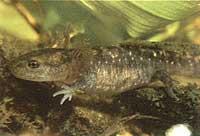
El arrabio ( Salamandra salamandra), besides being the best known urodelo of the Basque Country, is one of the driest animals of this group. The characteristics of this terrestrial character are appreciated in their morphology, behaviors, physiology, and of course, reproduction.
Dry fertilization occurs in the walls and therefore the front courtship.
The ferret's heat occurs in autumn and can be prolonged during the winter. At this time, sexually active males leave it when there is a female, to place themselves on top and thus "catch" (1). With the female paralyzed, the male enters under the male (2) and with the front legs, lifts the head and rubs the female's potato moving the end from side to side (3). At that time you can see a great excitement in the worm, with a rapid body panic that shakes the trunk and tail. Then, if these movements stop, the male leaves a spermatoforum on the ground thanks to the contractions of the muscles surrounding the sewer. In this way, the male moves the back of the body to form a 90º angle with the female. Finally, the female receives the spermatoforum (4). The internalized sperm is stored in the female's sperm shop, where eggs can fertilize almost a year later.

But probably the most important trait that explains the terrestrial character of the harlot lies in the viviparity of these animals. This type of reproduction is an obvious exception among the urodelos. In fact, the suburbs are on track to overcome the amphibious life cycle divided into two zones.
In the case of the black suburb that inhabits the Alpe Mountains — Salamandra atra —, viviparity is total and the larvae do not have a free life. The larvae develop until they complete the metamorphosis in the female's eggs, one or two in each of them, being completely dry at birth.
Salamander salamander ssp. fastuosa —, or in the case of common arrabio, bibiparity is usually not complete. The female gives birth in a well or river to the larvae that hatch and develop in the oils. The number of medium larvae (2 to 50) and their degree of development are variable, relating this variability to external conditions.
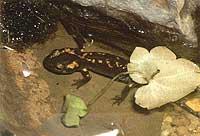
The peculiarities mentioned, together with many other characteristics that can be observed in the different fields of the biology of these animals, make the urodelos constitute one of the most interesting groups among vertebrates, being a life cycle anfibione distributed in aquatic and terrestrial media, located on an evolutionary cross of paths that allows to develop numerous strategies.
